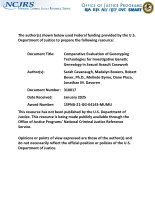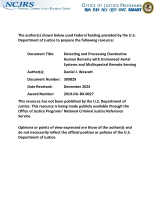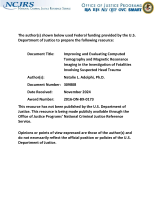Best practices
Police Early Intervention Systems: The State of the Art
Evidence Management Steering Committee Report: Opportunities to Strengthen Evidence Management Processes
A postconviction mentality
When DNA Is and Isn't Magic: A Conjunctive Analysis of How Context Matters in Homicide Investigations
National Study of Family Treatment Court Best Practices, Outcomes, and Costs
Just Science Podcast: Just Advancements in Death Investigation Practices
Implementing Law Enforcement-Based Victim Services: A Research Note on Considerations for Rural Communities
Impact Evaluation of Complementarities Between PBIS and Restorative Justice
Comparative Evaluation of Genotyping Technologies for Investigative Genetic Genealogy in Sexual Assault Casework
Infusing Evidence into Police Reform: Field Initiated Action Research with the Louisville Metro Police Department
Detecting and Processing Clandestine Human Remains with Unmanned Aerial Systems and Multispectral Remote Sensing
ILIAD: A Suite of Automated Snakemake Workflows for Processing Genomic Data for Downstream Applications
Improving and Evaluating Computed Tomography and Magnetic Resonance Imaging in the Investigation of Fatalities Involving Suspected Head Trauma
Incorporating Those with Lived Experience to Improve Community Supervision Outcomes
Securing Officer Buy-in When a Beneficial Technology Increases Workload: Best Practices for Implementing Gunshot Detection Technology
Optimizing Public Surveillance Systems for Crime Control and Prevention: A Guide for Law Enforcement and their Municipal Partners
Readiness to Implement Evidence-Based Practices in Public Elementary Schools
Advancing Justice for the Missing and Unidentified Through Research - 2024 NIJ Research Conference
Forensic science research is developing essential knowledge to fill in the holes in death investigations, creating new ways to identify challenging skeletal remains. These methods inform cause of death, time of death, and familial relationships to guide investigations, identify suspects, support prosecutions, and bring justice to families.
See the YouTube Terms of Service and Google Privacy Policy








